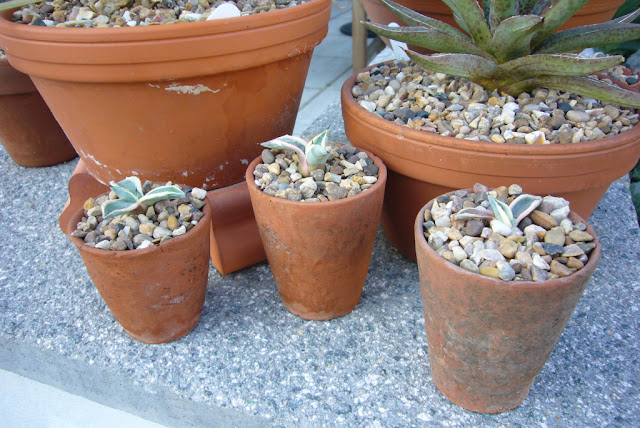With all the new pots, it is easy to forget about the two larger alpine planters that have been created over the last couple of years.
I can't remember what the plant was that is missing. Strangely I don't have a photo of it when planted, but I am guessing it has not grown much as two of the plant are known to be slow growers.
The next one was suppose to be quicker.
The little androsace sempervivoides (top right), flowered and then died. I have another else where in the garden and that hasn't done well either.
The orostachys spinosas (centre middle, and top) both struggled last year shrinking right back. I thought they were gone, but this year they seem to be making a bit of a recovery. For both of these water is probably key and they can't cope with baking.
The two sempervivums have both thrived. I hadn't noticed them growing, but the photos show how much more space they are taking up. Red devil has got quite big, for something I thought stayed small. The green dragon, is just doing it's thing, slowly creeping out with lots of little plants.
The eagle eyed among you, may have noticed two semps were removed from beside the red devil. These turned out to be a different form and have been moved.
The other plant, armeria juniperifolia, has done well. Again water is an issue, got to keep an eye on it as it has a tendancy to suddely turn brown in sections, which totally spoils the look.
And what happened to the other sempervivum, it is now all planted up with a semp lilac time.
They look slighty dwarfed at the moment, but it is semp 'lion king' so wont stay that way for long. Hopefully the two should work well together, as 'Lion King' looks best in spring and then fades a bit, which 'lilac time' gets better as the summer progresses.
The main thing I learnt from last year is not to treat them like succulents in high summer. They need a bit of shade or more water. I am determined to get it right this time and actualy take notice of the water needs.
I can't remember what the plant was that is missing. Strangely I don't have a photo of it when planted, but I am guessing it has not grown much as two of the plant are known to be slow growers.
The next one was suppose to be quicker.
The little androsace sempervivoides (top right), flowered and then died. I have another else where in the garden and that hasn't done well either.
The orostachys spinosas (centre middle, and top) both struggled last year shrinking right back. I thought they were gone, but this year they seem to be making a bit of a recovery. For both of these water is probably key and they can't cope with baking.
The two sempervivums have both thrived. I hadn't noticed them growing, but the photos show how much more space they are taking up. Red devil has got quite big, for something I thought stayed small. The green dragon, is just doing it's thing, slowly creeping out with lots of little plants.
The eagle eyed among you, may have noticed two semps were removed from beside the red devil. These turned out to be a different form and have been moved.
The other plant, armeria juniperifolia, has done well. Again water is an issue, got to keep an eye on it as it has a tendancy to suddely turn brown in sections, which totally spoils the look.
And what happened to the other sempervivum, it is now all planted up with a semp lilac time.
They look slighty dwarfed at the moment, but it is semp 'lion king' so wont stay that way for long. Hopefully the two should work well together, as 'Lion King' looks best in spring and then fades a bit, which 'lilac time' gets better as the summer progresses.
The main thing I learnt from last year is not to treat them like succulents in high summer. They need a bit of shade or more water. I am determined to get it right this time and actualy take notice of the water needs.




















































































































